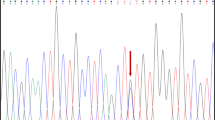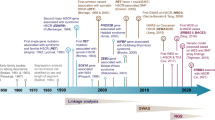Abstract
Hirschsprung disease (HSCR, aganglionic megacolon) is a complex genetic disorder of the enteric nervous system (ENS) characterized by the absence of enteric neurons along a variable length of the intestine. While rare variants (RVs) in the coding sequence (CDS) of several genes involved in ENS development lead to disease, the association of common variants (CVs) with HSCR has only been reported for RET (the major HSCR gene) and NRG1. Importantly, RVs in the CDS of these two genes are also associated with the disorder. To assess independent and joint effects between the different types of RET and NRG1 variants identified in HSCR patients, we used 254 Chinese sporadic HSCR patients and 143 ethnically matched controls for whom the RET and/or NRG1 variants genotypes (rare and common) were available. Four genetic risk factors were defined and interaction effects were modeled using conditional logistic regression analyses and pair-wise Kendall correlations. Our analysis revealed a joint effect of RET CVs with RET RVs, NRG1 CVs or NRG1 RVs. To assess whether the genetic interaction translated into functional interaction, mouse neural crest cells (NCCs; enteric neuron precursors) isolated from embryonic guts were treated with NRG1 (ErbB2 ligand) or/and GDNF (Ret ligand) and monitored during the subsequent neural differentiation process. Nrg1 inhibited the Gdnf-induced neuronal differentiation and Gdnf negatively regulated Nrg1-signaling by down-regulating the expression of its receptor, ErbB2. This preliminary data suggest that the balance neurogenesis/gliogenesis is critical for ENS development.


Similar content being viewed by others
References
Altshuler D, Daly MJ, Lander ES (2008) Genetic mapping in human disease. Science 322:881–888
Amiel J, Sproat-Emison E, Garcia-Barcelo M, Lantieri F, Burzynski G, Borrego S, Pelet A, Arnold S, Miao X, Griseri P, Brooks AS, Antinolo G, de Pontual PL, Clement-Ziza M, Munnich A, Kashuk C, West K, Wong KK, Lyonnet S, Chakravarti A, Tam PK, Ceccherini I, Hofstra RM, Fernandez R (2008) Hirschsprung disease, associated syndromes and genetics: a review. J Med Genet 45:1–14
Auricchio A, Casari G, Staiano A, Ballabio A (1996) Endothelin-B receptor mutations in patients with isolated Hirschsprung disease from a non-inbred population. Hum Mol Genet 5:351–354
Barlow A, de Graaff E, Pachnis V (2003) Enteric nervous system progenitors are coordinately controlled by the G protein-coupled receptor EDNRB and the receptor tyrosine kinase RET. Neuron 40:905–916
Berrington de Gonzalez A, Cox DR (2005) Additive and multiplicative models for the joint effect of two risk factors. Biostatistics 6:1–9
Bodmer W, Bonilla C (2008) Common and rare variants in multifactorial susceptibility to common diseases. Nat Genet 40:695–701
Boon CJ, Klevering BJ, Hoyng CB, Zonneveld-Vrieling MN, Nabuurs SB, Blokland E, Cremers FP, den Hollander AI (2008) Basal laminar drusen caused by compound heterozygous variants in the CFH gene. Am J Hum Genet 82:516–523
Britsch S (2007) The neuregulin-I/ErbB signaling system in development and disease. Adv Anat Embryol Cell Biol 190:1–65
Carrasquillo MM, McCallion AS, Puffenberger EG, Kashuk CS, Nouri N, Chakravarti A (2002) Genome-wide association study and mouse model identify interaction between RET and EDNRB pathways in Hirschsprung disease. Nat Genet 32:237–244
Clayton DG (2009) Prediction and interaction in complex disease genetics: experience in type 1 diabetes. PLoS Genet 5:e1000540
Cornes BK, Tang CS, Leon TY, Hui KJ, So MT, Miao X, Cherny SS, Sham PC, Tam PK, Garcia-Barcelo MM (2010) Haplotype analysis reveals a possible founder effect of RET mutation R114H for Hirschsprung’s disease in the Chinese population. PLoS ONE 5:e10918
Demidenko E (2008) Sample size and optimal design for logistic regression with binary interaction. Stat Med 27:36–46
Eichler EE, Flint J, Gibson G, Kong A, Leal SM, Moore JH, Nadeau JH (2010) Missing heritability and strategies for finding the underlying causes of complex disease. Nat Rev Genet 11:446–450
Emison ES, McCallion AS, Kashuk CS, Bush RT, Grice E, Lin S, Portnoy ME, Cutler DJ, Green ED, Chakravarti A (2005) A common sex-dependent mutation in a RET enhancer underlies Hirschsprung disease risk. Nature 434:857–863
Emison ES, Garcia-Barcelo M, Grice EA, Lantieri F, Amiel J, Burzynski G, Fernandez RM, Hao L, Kashuk C, West K, Miao X, Tam PK, Griseri P, Ceccherini I, Pelet A, Jannot AS, de Pontual L, Henrion-Caude A, Lyonnet S, Verheij JB, Hofstra RM, Antinolo G, Borrego S, McCallion AS, Chakravarti A (2010) Differential contributions of rare and common, coding and noncoding ret mutations to multifactorial Hirschsprung disease liability. Am J Hum Genet 87:60–74
Falls DL (2003) Neuregulins: functions, forms, and signaling strategies. Exp Cell Res 284:14–30
Garcia-Barcelo M, Ganster RW, Lui VC, Leon TY, So MT, Lau AM, Fu M, Sham MH, Knight J, Zannini MS, Sham PC, Tam PK (2005) TTF-1 and RET promoter SNPs: regulation of RET transcription in Hirschsprung’s disease. Hum Mol Genet 14:191–204
Garcia-Barcelo M, Amiel J, Antinolo G, Borrego S, Burzynski GM, Ceccherini I, Emison ES, Eng C, Fernandez RM, Griseri P, Hofstra R, Kashuk C, Lantieri F, Lyonnet S, Miao X, Tam P, Tullio-Pelet A, West A, Chakravarti A (2006) Higher prevalence of Hirschsprung disease in China explained by a common RET mutation. 56th Annual Meeting of the American Society of Human Genetics, New Orleans
Garcia-Barcelo MM, Tang CS, Ngan ES, Lui VC, Chen Y, So MT, Leon TY, Miao XP, Shum CK, Liu FQ, Yeung MY, Yuan ZW, Guo WH, Liu L, Sun XB, Huang LM, Tou JF, Song YQ, Chan D, Cheung KM, Wong KK, Cherny SS, Sham PC, Tam PK (2009) Genome-wide association study identifies NRG1 as a susceptibility locus for Hirschsprung’s disease. Proc Natl Acad Sci USA 106:2694–2699
Grice EA, Rochelle ES, Green ED, Chakravarti A, McCallion AS (2005) Evaluation of the RET regulatory landscape reveals the biological relevance of a HSCR-implicated enhancer. Hum Mol Genet 14:3837–3845
Griseri P, Bachetti T, Puppo F, Lantieri F, Ravazzolo R, Devoto M, Ceccherini I (2005) A common haplotype at the 5′ end of the RET proto-oncogene, overrepresented in Hirschsprung patients, is associated with reduced gene expression. Hum Mutat 25:189–195
Heanue TA, Pachnis V (2007) Enteric nervous system development and Hirschsprung’s disease: advances in genetic and stem cell studies. Nat Rev Neurosci 8:466–479
Miao X, Garcia-Barcelo MM, So MT, Leon TY, Lau DK, Liu TT, Chan EK, Lan LC, Wong KK, Lui VC, Tam PK (2007) Role of RET and PHOX2B gene polymorphisms in risk of Hirschsprung’s disease in Chinese population. Gut 56:736
Miao X, Leon TY, Ngan ES, So MT, Yuan ZW, Lui VC, Chen Y, Wong KK, Tam PK, Garcia-Barcelo M (2010) Reduced RET expression in gut tissue of individuals carrying risk alleles of Hirschsprung’s disease. Hum Mol Genet 19:1461–1467
Moore SW, Zaahl MG (2012) Intronic RET gene variants in Down syndrome-associated Hirschsprung disease in an African population. J Pediatr Surg 47:299–302
Ngan ES, Lee KY, Sit FY, Poon HC, Chan JK, Sham MH, Lui VC, Tam PK (2007) Prokineticin-1 modulates proliferation and differentiation of enteric neural crest cells. Biochim Biophys Acta 1773(4):536–545
Ngan ES, Shum CK, Poon HC, Sham MH, Garcia-Barcelo MM, Lui VC, Tam PK (2008) Prokineticin-1 (Prok-1) works coordinately with glial cell line-derived neurotrophic factor (GDNF) to mediate proliferation and differentiation of enteric neural crest cells. Biochim Biophys Acta 1783:467–478
Ngan ES, Garcia-Barcelo MM, Yip BH, Poon HC, Lau ST, Kwok CK, Sat E, Sham MH, Wong KK, Wainwright BJ, Cherny SS, Hui CC, Sham PC, Lui VC, Tam PK (2011) Hedgehog/Notch-induced premature gliogenesis represents a new disease mechanism for Hirschsprung disease in mice and humans. J Clin Invest 121:3467–3478
Nunez-Torres R, Fernandez RM, Acosta MJ, Enguix-Riego Mdel V, Marba M, Carlos de Agustin J, Castano L, Antinolo G, Borrego S (2011) Comprehensive analysis of RET common and rare variants in a series of Spanish Hirschsprung patients confirms a synergistic effect of both kinds of events. BMC Med Genet 12:138
Pachnis V, Durbec P, Taraviras S, Grigoriou M, Natarajan D (1998) III. Role of the RET signal transduction pathway in development of the mammalian enteric nervous system. Am J Physiol 275:G183–G186
Phusantisampan T, Sangkhathat S, Phongdara A, Chiengkriwate P, Patrapinyokul S, Mahasirimongkol S (2012) Association of genetic polymorphisms in the RET-protooncogene and NRG1 with Hirschsprung disease in Thai patients. J Hum Genet 57:286–293
Purcell S, Neale B, Todd-Brown K, Thomas L, Ferreira MA, Bender D, Maller J, Sklar P, de Bakker PI, Daly MJ, Sham PC (2007) PLINK: a tool set for whole-genome association and population-based linkage analyses. Am J Hum Genet 81:559–575
Raychaudhuri S, Iartchouk O, Chin K, Tan PL, Tai AK, Ripke S, Gowrisankar S, Vemuri S, Montgomery K, Yu Y, Reynolds R, Zack DJ, Campochiaro B, Campochiaro P, Katsanis N, Daly MJ, Seddon JM (2011) A rare penetrant mutation in CFH confers high risk of age-related macular degeneration. Nat Genet 43:1232–1236
Sanchez-Mejias A, Fernandez RM, Lopez-Alonso M, Antinolo G, Borrego S (2009) Contribution of RET, NTRK3 and EDN3 to the expression of Hirschsprung disease in a multiplex family. J Med Genet 46:862–864
Schuchardt A, D’Agati V, Larsson-Blomberg L, Costantini F, Pachnis V (1994) Defects in the kidney and enteric nervous system of mice lacking the tyrosine kinase receptor Ret. Nature 367:380–383
So MT, Leon TY, Cheng G, Tang CS, Miao XP, Cornes BK, Diem NN, Cui L, Ngan ES, Lui VC, Wu XZ, Wang B, Wang H, Yuan ZW, Huang LM, Li L, Xia H, Zhu D, Liu J, Nguyen TL, Chan IH, Chung PH, Liu XL, Zhang R, Wong KK, Sham PC, Cherny SS, Tam PK, Garcia-Barcelo MM (2011) RET mutational spectrum in Hirschsprung disease: evaluation of 601 Chinese patients. PLoS ONE 6:e28986
Sribudiani Y, Metzger M, Osinga J, Rey A, Burns AJ, Thapar N, Hofstra RM (2011) Variants in RET associated with Hirschsprung’s disease affect binding of transcription factors and gene expression. Gastroenterology 140:572e2–582e2
Tang CS, Tang WK, So MT, Miao XP, Leung BM, Yip BH, Leon TY, Ngan ES, Lui VC, Chen Y, Chan IH, Chung PH, Liu XL, Wu XZ, Wong KK, Sham PC, Cherny SS, Tam PK, Garcia-Barcelo MM (2011) Fine mapping of the NRG1 Hirschsprung’s disease locus. PLoS ONE 6:e16181
Tang CS, Ngan ES, Tang WK, So MT, Cheng G, Miao XP, Leon TY, Leung BM, Hui KJ, Lui VH, Chen Y, Chan IH, Chung PH, Liu XL, Wong KK, Sham PC, Cherny SS, Tam PK, Garcia-Barcelo MM (2012a) Mutations in the NRG1 gene are associated with Hirschsprung disease. Hum Genet 131:67–76
Wu MC, Lee S, Cai T, Li Y, Boehnke M, Lin X (2011) Rare-variant association testing for sequencing data with the sequence kernel association test. Am J Hum Genet 89:82–93
Yatani K (2011) Statistics for HCI research: logistic regression. http://yatani.jp/HCIstats/LogisticRegression#Nagelkerke. Accessed 30 Jan 2013
Acknowledgments
This work was supported by the research grant from the Hong Kong Research Grants Council HKU 778610 to P.K.T. and HKU775710 to E.S.W.N. Support was also received from the University of Hong Kong Strategic Research Theme on Genomics.
Author information
Authors and Affiliations
Corresponding authors
Additional information
H. Gui and W.-K. Tang contributed equally to this work.
Electronic supplementary material
Below is the link to the electronic supplementary material.
Rights and permissions
About this article
Cite this article
Gui, H., Tang, WK., So, MT. et al. RET and NRG1 interplay in Hirschsprung disease. Hum Genet 132, 591–600 (2013). https://doi.org/10.1007/s00439-013-1272-9
Received:
Accepted:
Published:
Issue Date:
DOI: https://doi.org/10.1007/s00439-013-1272-9




